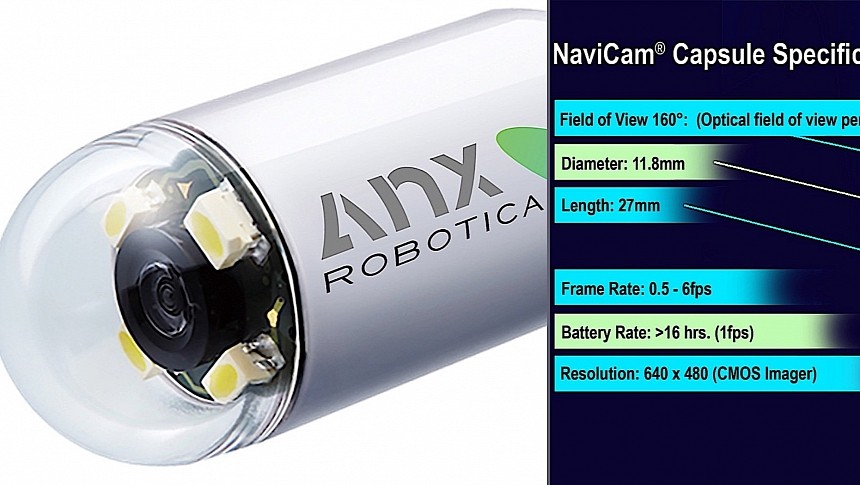Advanced it is today, medicine is still a long way from becoming the science that has eradicated illness and made humans live much, much longer. That probably won't happen during our lifetimes, so we'll never get to see nanites at work repairing tissue, some magic foam to close up wounds and stop bleeding, or even the miniaturization of humans so that they get inside the human body to repair stuff. But interesting things are being developed on a constant basis in this field, and some of them are quite extraordinary.
There are presently several ways doctors can see inside the human body. Among the most recent tech to facilitate that is the ingestible camera capsule: a pill-sized video camera designed to be swallowed, move through the body in search of issues, and then eliminated.
The procedure is called capsule endoscopy, and it does have its merits. It also has a very big limitation, as the capsule itself is not controllable in any way, and only passes through the body driven by gravity and the body itself. But an upgrade to this tech, in the works over at the George Washington University in D.C., might change all that.
The scientists working on this idea call it a first-of-its-kind. It's centered on the video capsules we already know and use, only enhanced by an external magnet that allows physicians to literally steer the thing inside your body with purpose, sending it to areas it might otherwise not go, or pass without looking very closely.
Called NaviCam, the system has been put together by a company called AnX Robotica, and put through its paces during a never-before conducted study in the U.S., performed on 40 people.
The idea behind the tech is rather simple, really. It's not unlike when any one of us uses two magnets, placed on either side of a table, to trick people at parties.
In this case though, a doctor is not moving, by hand, a magnet over the patient's body to steer the capsule. Instead, a videogame-like joystick is used for the task of controlling the external magnet.
During the study, whose results were already published in an online journal called iGIE, the magnet-driven camera capsule proved it could reach most places in a stomach with a 95 percent rate of visualization. The study also showed the method did not miss anything usually spotted during traditional endoscopies.
The people behind the idea say using the joystick to move the camera may require a bit of getting used to, but they also say AI software is now being put together to make the capsule, in essence, autonomous as it moves inside people's bodies.
The benefits of the tech are obvious, and the most important is the fact a diagnosis can be made very quickly compared to traditional means of internal exploration. Also, there seems to be no side effects from using the magnet to control the capsule.
We are told though the tech still has some way to go before becoming available and widespread, with a "much bigger trial" on the horizon.
The procedure is called capsule endoscopy, and it does have its merits. It also has a very big limitation, as the capsule itself is not controllable in any way, and only passes through the body driven by gravity and the body itself. But an upgrade to this tech, in the works over at the George Washington University in D.C., might change all that.
The scientists working on this idea call it a first-of-its-kind. It's centered on the video capsules we already know and use, only enhanced by an external magnet that allows physicians to literally steer the thing inside your body with purpose, sending it to areas it might otherwise not go, or pass without looking very closely.
Called NaviCam, the system has been put together by a company called AnX Robotica, and put through its paces during a never-before conducted study in the U.S., performed on 40 people.
The idea behind the tech is rather simple, really. It's not unlike when any one of us uses two magnets, placed on either side of a table, to trick people at parties.
In this case though, a doctor is not moving, by hand, a magnet over the patient's body to steer the capsule. Instead, a videogame-like joystick is used for the task of controlling the external magnet.
During the study, whose results were already published in an online journal called iGIE, the magnet-driven camera capsule proved it could reach most places in a stomach with a 95 percent rate of visualization. The study also showed the method did not miss anything usually spotted during traditional endoscopies.
The people behind the idea say using the joystick to move the camera may require a bit of getting used to, but they also say AI software is now being put together to make the capsule, in essence, autonomous as it moves inside people's bodies.
The benefits of the tech are obvious, and the most important is the fact a diagnosis can be made very quickly compared to traditional means of internal exploration. Also, there seems to be no side effects from using the magnet to control the capsule.
We are told though the tech still has some way to go before becoming available and widespread, with a "much bigger trial" on the horizon.







